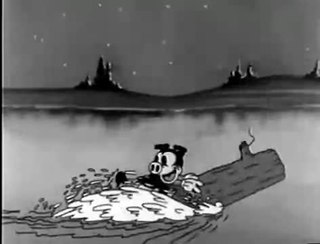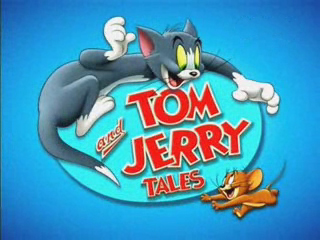
Warner Bros. Entertainment Inc. is an American film and entertainment studio headquartered at the Warner Bros. Studios complex in Burbank, California, and a subsidiary of Warner Bros. Discovery. Founded in 1923 by four brothers, Harry, Albert, Sam, and Jack Warner, the company established itself as a leader in the American film industry before diversifying into animation, television, and video games, and is one of the "Big Five" major American film studios, as well as a member of the Motion Picture Association (MPA).

Looney Tunes is an American animated comedy short film series produced by Warner Bros. from 1930 to 1969, concurrently with its partner series Merrie Melodies, during the golden age of American animation. The two series introduced a large cast of characters, including Bugs Bunny, Daffy Duck, and Porky Pig. The term Looney Tunes has since been expanded to also refer to the characters themselves.

The Censored Eleven is a group of Looney Tunes and Merrie Melodies cartoons originally produced and released by Warner Bros. that were withheld from syndication in the United States by United Artists (UA) since 1968. UA owned the distribution rights to the Associated Artists Productions library at that time, and decided to pull these 11 cartoons from broadcast because the use of ethnic stereotypes in the cartoons, specifically African stereotypes, was deemed too offensive for contemporary audiences. The ban has been continued by UA and the successive owners of the pre-August 1948 Looney Tunes/Merrie Melodies. Since 1968, these shorts have not been officially broadcast on television and have only been exhibited theatrically by Warner Bros. once since their withdrawal. They have turned up, however, on low-cost VHS and DVD collections.

Ripley's Believe It or Not! was an American franchise founded by Robert Ripley, which deals in bizarre events and items so strange and unusual that readers might question the claims. Originally a newspaper panel, the Believe It or Not feature proved popular and was later adapted into a wide variety of formats, including radio, television, comic books, a chain of museums and a book series.

LeRoy Robert Ripley was an American cartoonist, entrepreneur, and amateur anthropologist, who is known for creating the Ripley's Believe It or Not! newspaper panel series, television show, and radio show, which feature odd facts from around the world.

Famous Studios was the first animation division of the film studio Paramount Pictures from 1942 to 1967. Famous was founded as a successor company to Fleischer Studios, after Paramount seized control of the aforementioned studio after the departure of its founders, Max and Dave Fleischer, in 1942. The studio's productions included three series started by the Fleischers—Popeye the Sailor, Superman, and Screen Songs—as well as Little Audrey, Little Lulu, Casper the Friendly Ghost, Honey Halfwitch, Herman and Katnip, Baby Huey, and the anthology Noveltoons series.

Warner Bros. Animation Inc. is an American animation studio which is part of the Warner Bros. Television Studios division of Warner Bros., a flagship of Warner Bros. Discovery. As the successor to Warner Bros. Cartoons, which was active from 1933 to 1969, the studio is closely associated with the Looney Tunes and Merrie Melodies characters, among others. Warner Bros. re-established its animation division in 1980 to produce Looney Tunes–related works, and Turner Broadcasting System merged with WBD predecessor Time Warner in 1996. In March 2001, Hanna-Barbera was absorbed into the studio.

Our Gang is an American series of comedy short films chronicling a group of poor neighborhood children and their adventures. Created by film producer Hal Roach, also the producer of the Laurel and Hardy films, Our Gang shorts were produced from 1922 to 1944, spanning the silent film and early sound film periods of American cinema. Our Gang is noted for showing children behaving in a relatively natural way; Roach and original director Robert F. McGowan worked to film the unaffected, raw nuances apparent in regular children, rather than have them imitate adult acting styles. The series also broke new ground by portraying white and black children interacting as equals during the Jim Crow era of racial segregation in the United States.

Associated Artists Productions, Inc. (a.a.p.) later known as United Artists Associated was an American distributor of theatrical feature films and short subjects for television. Associated Artists Productions was the copyright owner of the Popeye shorts by Paramount Pictures, and the pre-1950 Warner Bros. film library, notably the pre-1948 color Looney Tunes and Merrie Melodies series of animated shorts, and the black-and-white Merrie Melodies shorts from Hugh Harman and Rudolf Ising sans "Lady, Play Your Mandolin!"

Tom and Jerry Tales is an American-Canadian animated television series featuring the cat-and-mouse duo Tom and Jerry. Produced by Warner Bros. Animation and Turner Entertainment, it is the seventh installment in the Tom and Jerry franchise as well as the first Tom and Jerry production to emulate the original theatrical shorts created by Hanna-Barbera founders and former Metro-Goldwyn-Mayer cartoon studio staff William Hanna and Joseph Barbera for Metro-Goldwyn-Mayer; it originally ran in the United States from September 23, 2006 to March 22, 2008, on Kids' WB. This is the first Tom and Jerry television series from Warner Bros. Animation after parent company Time Warner had bought Turner Broadcasting System, then-owners of the franchise, in 1996.

Popeye the Sailor is an American animated series of short films based on the Popeye comic strip character created by E. C. Segar. In 1933, Max and Dave Fleischer's Fleischer Studios adapted Segar's characters into a series of theatrical cartoon shorts for Paramount Pictures. The plotlines in the animated cartoons tended to be simpler than those presented in the comic strips, and the characters slightly different. A villain, usually Bluto, makes a move on Popeye's "sweetie", Olive Oyl. The villain clobbers Popeye until he eats spinach, giving him superhuman strength. Thus empowered, Popeye the sailor makes short work of the villain.
Bubbles is a 1930 American Vitaphone Varieties short film released by Warner Bros. in Technicolor. It was filmed in December 1929 at the First National Pictures studio with Western Electric apparatus, an early sound-on-film system, Rel. No. 3898. Bubbles is one of the earliest surviving recordings of Judy Garland on film, at 8 years old.
The Sport Slants and its follow-up “Sports Thrills” were a series of documentary film shorts produced by Warner Brothers and hosted by the top sports caster of the 1930s, Ted Husing.
Adventures in Africa is a series of Warner Bros. documentary film shorts inspired by the success of Martin and Osa Johnson and concurrent features such as Africa Speaks! and Trader Horn.
Vitaphone Varieties is a series title used for all of Warner Bros.', earliest short film "talkies" of the 1920s, initially made using the Vitaphone sound on disc process before a switch to the sound-on-film format early in the 1930s. These were the first major film studio-backed sound films, initially showcased with the 1926 synchronized scored features Don Juan and The Better 'Ole. Although independent producers like Lee de Forest's Phonofilm were successfully making sound film shorts as early as 1922, they were very limited in their distribution and their audio was generally not as loud and clear in theaters as Vitaphone's. The success of the early Vitaphone shorts, initially filmed only in New York, helped launch the sound revolution in Hollywood.
The Big V Comedies were two-reel comedy film shorts produced by Warner Bros. and Vitaphone between 1931 and 1938, contemporary of the more famous Hal Roach, Mack Sennett and Columbia Pictures comedies.
The Melody Masters were a series of first-rate big band musical film shorts produced by Warner Brothers, under the supervision of Samuel Sax at their Vitaphone studio in New York between 1931 and 1939, and in Burbank, California with producer Gordon Hollingshead in charge between 1940 and 1946.
The Naggers was a series of 18 film short films produced by Warner Brothers at the Vitaphone studio in Brooklyn, New York. These featured Jack Norworth and Dorothy Adelphi as an arguing husband and wife in a variety of domestic settings. This basic premise predated the popular radio series The Bickersons and many future TV marital comedies.
The Egg Collector is a 1940 Warner Bros. Merrie Melodies directed by Chuck Jones. The short was released on July 20, 1940, and stars Sniffles.
Tex Avery Screwball Classics is a series of single-disc Blu-ray and DVD sets by Warner Bros. Home Entertainment's Warner Archive unit collecting various theatrical cartoons from animation director Tex Avery during his tenure at the Metro-Goldwyn-Mayer's cartoon division between the years of 1942 and 1955. It is the first comprehensive collection of Avery's MGM shorts to be released on home media in North America since The Compleat Tex Avery series of laserdiscs in the 1990s, with many of the shorts having been previously unreleased on DVD or Blu-ray.











